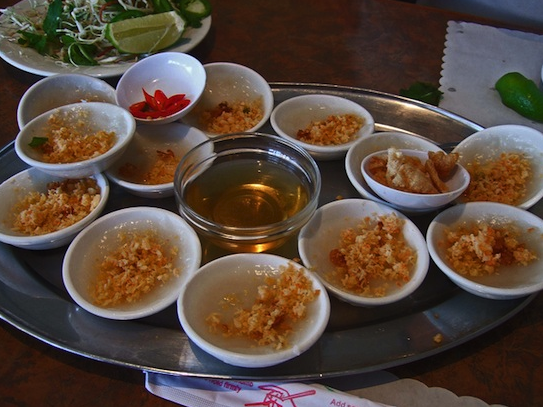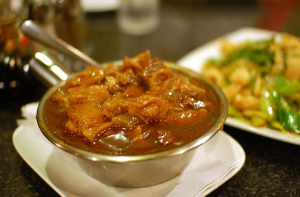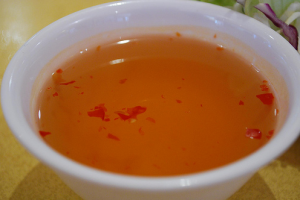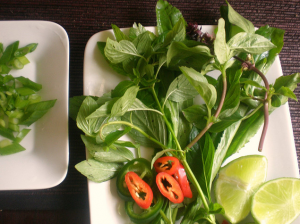diaCRITICS will periodically have guest blogs. Dave Lieberman wrote this post in June 2011 for Stick A Fork In It at OCWeekly. His impassioned list of six recommendations for “would-be connoisseurs of Vietnamese food” is a useful primer on appreciating Vietnamese cuisine, for those needing some gentle (if even admonishing) instruction in the arts.
Do you enjoy reading diaCRITICS? Then please consider subscribing!

Dear would-be connoisseurs of Vietnamese food:
We’ve never met, but I’ve read your body of work on Yelp. Some of you really get it, and I bookmark places I think look likely. The nice thing about Vietnamese food is that no matter how often I eat it, there’s more to learn–and I’ve been introduced to more than one favorite by sites like Yelp and Chowhound. Some of you are making your first forays into a new cuisine, an admirable step, made more admirable by admissions like “perhaps I don’t understand” when you are panning a dish…
… and then there are those of you who make reading Little Saigon-area reviews an exercise in frustration. Your M.O. seems to be peremptory dismissal of an entire cuisine because you went one time with firm guards up against having a good time. It wouldn’t be such a big deal, except that Yelp reviews have a concrete effect on businesses, and not everyone has the finely-tuned crap detector I’ve developed in years of reading that site. Following these few suggestions will make your experience better and my time on Yelp better spent.
1. Please stop with the dog jokes.

”What do you call a man walking a dog in Garden Grove?” “A vegetarian.” Oh, how droll. Did you think that up all by yourself, or did it come from a time capsule from thirty-plus years ago, when ignorant jokes about Vietnamese refugees were all the rage? If the meat was poor quality, say so in your Yelp review, but don’t intimate that it might have died with a woof instead of a moo. It’s a tired stereotype, and it just makes you look bigoted and stupid when you say it. No Vietnamese restaurant in California serves dog meat. Get over it.
2. Learn to order what everyone else is ordering.

Vietnamese restaurants are specialists, much mores than Americans. A phở shop sells beef (or chicken) noodle soup and not much else. A Central Vietnamese restaurant is going to specialize in food from the region around Huế and Đà Nẵng, which means the most likely soup on the menu is bún bò Huế. Complaining on Yelp that they don’t sell phở (or they do, and it’s bad) when they’re not a phở shop is like walking into Kentucky Fried Chicken and bitching that they don’t serve hamburgers. Vietnamese restaurants here in Orange County trumpet their specialities on the windows. When in doubt, look at what the Vietnamese families in the restaurant are eating; chances are, they’ve ordered what the restaurant is known for. If that fails, look for the words đặc biệt on the menu–it means “house special”.
3. The Vietnamese know there’s more to a cow than ribeye.

By far the biggest complaint about Vietnamese food–not the restaurants, but the food–is that it’s full of scary, squiggly bits. Yes, you can get phở tái (rare slices of filet mignon) or phở chín (brisket), but you’re missing out on some of the seminal parts of phở. By complaining about it, you’re reducing your credibility–and if you really hate all those internal bits of non-steak meat, please don’t order them. Chicken with bones in is tastier than boneless chicken (and if you’re one of those people for whom even chicken drumsticks are too exotic, you are frankly beyond help).
4. Get over the fish sauce quick.

Yes, it smells awful. Yes, if you try and deglaze a pan with fish sauce, you are going to have to evacuate for 200 feet in any direction. Yes, it’s honestly made by taking a big pile of fish and salt and pressing out the resulting liquid. It’s also the backbone of Vietnamese cooking, and Vietnamese cooks know how to use it to best effect. That dish of pinkish-orange fish sauce isn’t pure fish sauce; it’s been mixed with water, chiles, garlic, sugar and limes and is the best dipping sauce on the planet. It doesn’t taste like a bottle of plain fish sauce smells. The best part is the people who whine about the saucer of nước chấm, but have absolutely no problem eating Thai food, which uses just as much of the stinky elixir as Vietnamese food.
5. Learn to love the herbs.

Rare is the Vietnamese meal that doesn’t involve herbs. The French, with their love of tarragon, parsley and marjoram, have absolutely nothing on the leaf-mad Vietnamese. Plates of varied herbs, appropriate to the dishes ordered, appear on tables for the sole purpose of punching up the food to your liking. Comments on Yelp like “they forgot to dress the salad” miss the point. Some of those herbs are familiar–cilantro, basil and mint–and some aren’t as familiar. Some have an odd flavor–there’s one whose English name is usually rendered as “fish mint” for a reason–but they’re not meant to be eaten by themselves. If you don’t dress your food with the herbs, you’re missing the glory of Vietnamese food.
6. You aren’t going to change the service model.
The way service works in most non-high-end Vietnamese restaurants (which is most of them) is this: you pick what you want from the menu, you order it, it’s delivered, you get up and pay at the counter. Period. There will be no introductions, there may not be smiles, and frankly complaints about the food are not likely to result in the bill being adjusted. There may or may not be checks on your general dining welfare; if you want something, wave the waitstaff over politely. Writing screeds about how they didn’t dance attendance on you, French Laundry-style, is counterproductive. Everyone knows the rules in that restaurant except you, which means the issue is more than likely you.
And a special note to people complaining about the English skills of the waitstaff: this is a valid point to bring up in a review, but the second that’s paired with a comment about the rudeness of the service, I always have to wonder whose fault it was.
Looking for some good Vietnamese cookbooks? these are diaCRITICS certified:
[amazon_enhanced asin=”1580086659″ /][amazon_enhanced asin=”0762774495″ /][amazon_enhanced asin=”0060192585″ /]
–
Dave Lieberman blogs about food—in his ‘Stick a Fork in It’ column—at OCWeekly.
–
Please take the time to rate this post (above) and share it (below). Ratings for top posts are listed on the sidebar. Sharing (on email, Facebook, etc.) helps spread the word about diaCRITICS. And join the conversation and leave a comment! Where’s the best Vietnamese meal in your town?
Do you enjoy reading diaCRITICS? Then please consider subscribing!


